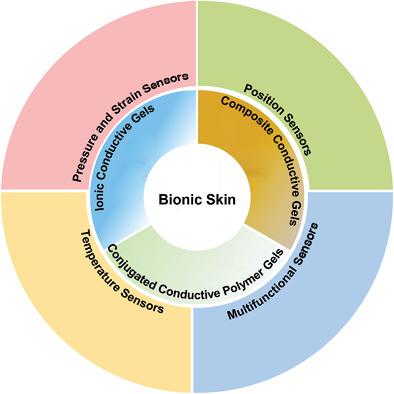当前位置:
X-MOL 学术
›
Macromol. Rapid Commun.
›
论文详情
Our official English website, www.x-mol.net, welcomes your feedback! (Note: you will need to create a separate account there.)
Recent Progress in Bionic Skin Based on Conductive Polymer Gels
Macromolecular Rapid Communications ( IF 4.6 ) Pub Date : 2021-09-10 , DOI: 10.1002/marc.202100480 Huijing Li 1, 2 , Guorong Gao 1, 2 , Zhenyu Xu 1, 2 , Diane Tang 3 , Tao Chen 1, 2
Macromolecular Rapid Communications ( IF 4.6 ) Pub Date : 2021-09-10 , DOI: 10.1002/marc.202100480 Huijing Li 1, 2 , Guorong Gao 1, 2 , Zhenyu Xu 1, 2 , Diane Tang 3 , Tao Chen 1, 2
Affiliation

|
Bionic skin sensors based on conductive polymer gels have garnered interest for their potential applications in human-computer interaction, soft robotics, biomedical systems, sports, and healthcare, because of their intrinsic flexibility and stretchability embedded at the material level, and other such as self-healing, adhesion, high, and low temperature tolerance properties that can be tuned through macromolecular design. Here, important advances in polymer gel-based flexible sensors over recent years are summarized, from material design, sensor fabrication to system-level applications. This review focuses on the representative strategies of design and preparing of conductive polymer gels, and adjusting their conductivity, mechanics, and other properties such as self-healing and adhesiveness by controlling the macromolecular network structures. The state-of-art of present flexible pressure and strain sensors, temperature sensors, position sensors, and multifunctional sensors based on capacitance, voltage, and resistance sensing technologies, are also systematically reviewed. Finally, perspectives on issues regarding further advances and challenges are provided.
中文翻译:

基于导电聚合物凝胶的仿生皮肤研究进展
基于导电聚合物凝胶的仿生皮肤传感器因其在人机交互、软机器人、生物医学系统、运动和医疗保健中的潜在应用而引起了人们的兴趣,因为它们在材料层面具有内在的灵活性和可拉伸性,以及其他如自我- 可通过大分子设计调整的愈合、粘附、耐高温和低温性能。在这里,总结了近年来基于聚合物凝胶的柔性传感器的重要进展,从材料设计、传感器制造到系统级应用。本综述重点介绍了导电聚合物凝胶的设计和制备的代表性策略,以及通过控制高分子网络结构来调整其导电性、力学和其他性能,如自愈性和粘附性。还系统回顾了目前基于电容、电压和电阻传感技术的柔性压力和应变传感器、温度传感器、位置传感器和多功能传感器的最新技术。最后,就有关进一步进展和挑战的问题提出了看法。
更新日期:2021-11-19
中文翻译:

基于导电聚合物凝胶的仿生皮肤研究进展
基于导电聚合物凝胶的仿生皮肤传感器因其在人机交互、软机器人、生物医学系统、运动和医疗保健中的潜在应用而引起了人们的兴趣,因为它们在材料层面具有内在的灵活性和可拉伸性,以及其他如自我- 可通过大分子设计调整的愈合、粘附、耐高温和低温性能。在这里,总结了近年来基于聚合物凝胶的柔性传感器的重要进展,从材料设计、传感器制造到系统级应用。本综述重点介绍了导电聚合物凝胶的设计和制备的代表性策略,以及通过控制高分子网络结构来调整其导电性、力学和其他性能,如自愈性和粘附性。还系统回顾了目前基于电容、电压和电阻传感技术的柔性压力和应变传感器、温度传感器、位置传感器和多功能传感器的最新技术。最后,就有关进一步进展和挑战的问题提出了看法。


























 京公网安备 11010802027423号
京公网安备 11010802027423号